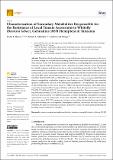| dc.description.abstract | Plants have developed mechanisms to cope with stresses in their environments as they grow in diverse settings. Such means include releasing plant defense compounds upon attacks by pests or other stressors. Plants with these characteristics are essential as a plant germplasm source for breeding resistance against herbivores and insect pests. Therefore, this study aimed to screen germplasms for whitefly resistance and characterize the secondary metabolites responsible for this. Thirty local tomato accessions were screened for resistance against whiteflies (Bemisia tabaci Gennadius) in the screen house located at Tanzania Plant Health and Pesticides Authority (PTHPA) between January and April 2021. From this screening, seven local tomato cultivars: TZA3729, TZA5554, TZA5545, TZA5562, TZA5552, TZA3177 and TZA5157, showed resistance, and one accession (TZA5496) that showed susceptibility to whiteflies (negative control) and accession V1030462 that was a standard (positive control) were selected for the subsequent experiments. The experiment was conducted in July–October 2021 in the screen house at TPHPA and repeated in January–April 2022 using a completely randomized block design with three replications. From this experiment, three accessions: TZA3729, TZA5562 and TZA5157, showed resistance against whiteflies. However, accession TZA3729 was more resistant than TZA5562 and TZA5157 when compared to the resistant accession V1030462. Therefore, these accessions were further screened for secondary metabolites responsible for resistance against herbivores and insect pests—in this case, whiteflies. The GS-MS methanol extract results showed accession TZA3729 to possess a wide array of secondary plant metabolites responsible for plant self-defenses, such as diterpenes, Tetraterpenes, alkaloids, carotenoids and fatty acid esters. Therefore, the study recommends accession TZA3729 as a source of tomato plant germplasm for breeding tomatoes resistant to whiteflies. | en_US |

